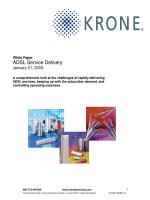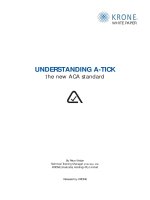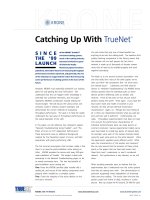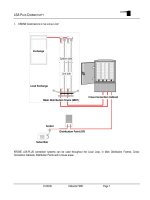Tài liệu KRONE - White Paper - The Future of UTP Structured Cabling System docx
Bạn đang xem bản rút gọn của tài liệu. Xem và tải ngay bản đầy đủ của tài liệu tại đây (83.94 KB, 4 trang )
KRONE
facts
KRONE (Australia) Holdings Pty Limited
2 Hereford Street Berkeley Vale NSW 2261
PO Box 335 Wyong NSW 2259
Phone: 02 4389 5000
Fax: 02 4388 4499
Help Desk: 1800 801 298
Email:
Web: www.krone.com.au
Job No 6194_V2 06/04
The Future of UTP
Although UTP cables have existed in one form or
another for decades, they have only been used in data
communications networks for just over 10 years. While
data cables existed in different forms for several decades
before UTP cables were predominantly used, they were
quickly replaced by UTP cables for several reasons.
Coax and shielded cabling solutions, such as ThickNet,
ThinNet and IBM type 1, were very good cables for
transmitting data within Local Area Networks (LANs).
With the advent and proliferation of computer
networking technologies, more and more cables
occupied spaces “behind the scenes” where cables had
only existed for telecommunications purposes in the
past. Telecommunications closets were expanded to
allow for connectivity between networking devices
(hubs), servers and workstation terminals. Data rates
were on the order of 1 to 16Mbps and ran on
proprietary cabling solutions. Several protocols existed
for proprietary to somewhat standardised, networks,
such as Token Ring, ISDN and ATM.
WHY UTP?
Space, time and cost constraints led to the development
of a more cost effective medium for transmitting data in
UTP cables. By eliminating the need for shielded
solutions the end user now needed less space for
installation, and saved money on materials and labour
for installation. Grounding issues were also mitigated.
Most importantly, UTP solutions are used as a baseline
interoperability media for the most prevalent protocols.
In most cases a cabling solution is developed to support
a faster transmission protocol. Today’s fastest protocol
over UTP cable is 1000BaseT transmission. This is
supported by both Category 5e and Category 6.
UTP AND THE END OF THE PROTOCOL WAR
To better understand why UTP cable has evolved from
Category 1 to Category 6, we must first understand the
primary driver i.e., data rate progression. In the early
‘90s a war was raging as to which protocol would
become the industry standard for LAN applications.
ATM, Token Ring and Ethernet were all in contention. By
the mid ‘90s Ethernet had come out on top. It provided
a highly accessible technology with an outstanding cost
basis that ultimately proved to provide the QoS needed
at the right price. In addition, the progression to
100Mbps transport assured that data rates would be
sufficient to support the needed bandwidth for existing
and up-and-coming applications.
The following chart provides a good example of the
progression of Ethernet as the default standard for
today’s LAN applications. As evidenced from the chart
10Mbps was the largest market share holder in 1995.
By 1999 100Mbps led the market as the protocol of
*Active “Powered” equipment only.
choice. At this time 1000Mbps had almost gained as
much market share as 10Mbps protocol. 2003 saw the
demand for 10Mbps completely dissipate. Currently, the
market is split between 100Mbps and 1000Mbps, with
100Mbps quickly on the decline.
Note: The “Other Protocols” in the first chart consist of
10 percent of the market consistently over the last six
years. These protocols are legacy systems, such as Token
Ring and ATM, and/or security systems.
The second chart above shows how historically the
cabling category installed has always led well before the
speed of the protocol supported is used. For example,
in 1995 the primary UTP cabling being installed was
Category 5, which could support 100Mbps, but the
switch ports sold that same year were primarily 10Mbps.
In 1999 the primary switch port speed sold was
100Mbps, but the primary cabling solutions, Category
5e and Category 6, supported 1000Mbps.
What this data tells us is that the cabling installed
always leads the primary data rate. This was the case
until 2004. Today our fastest data rate is 1000Mbps
over UTP. The cabling being sold today is only capable of
supporting 1000Mbps. Customers will want a cabling
solution that will support the next generation leap in
data transmission, 10Gbps.
WHY DO I NEED CATEGORY 6?
Originally Category 6 was developed to support a more
cost effective way of running 1000Mbps, by using two
pairs within the cable instead of all four. This is the
same way we currently run 100BaseTX and the reason
that 100BaseT4 never caught on. This would cut the
cost of transceivers within the active hardware. At the
time a leader in the telecommunications industry was
developing the hardware/protocol in question and
needed a cable that would extend the frequency
bandwidth used from the current 1-100MHz out to
250MHz. This allowed for higher bandwidth potential.
At the same time the development of four pair
transceivers using PAM5 encoding supported 1000BaseT
over Category 5e cables. These transceivers weren’t as
costly as initially expected. Today we see workstation PCs
shipped with 10/100/1000BaseT NIC’s integrated
directly on motherboards. Switch prices have come
down substantially and copper remains the most
economical way to run Gigabit within the LAN.
1000BaseT transmission was being embraced as the
latest, greatest protocol technology. Both Category 5e
and Category 6 cables were being sold to support it.
That’s right, Category 5e and Category 6 both support
up to 1000BaseT (Gigabit) Ethernet transmission
protocol.
A good argument has been made for installing Category
6 over 5e. Category 6 does give a much better signal to
noise ratio than 5e, at all frequencies. This allows for
anomalies within the active hardware that might
otherwise cause a greater number of errors on a lesser
performing 5e cabling system. This means systems may
run slower on Category 5e than on Category 6 cabling.
Category 6 does support broadband video applications
to a greater extent as well. At the same time the
extended frequency to 250MHz of Category 6 also gave
the customer a certain level of “future proofing”. The
industry seemed to adopt Category 6 with an attitude of
“build it and the protocol will come”. The International
Standards Organisation (ISO) has since ratified Class E
using Category 6 components and now that the cable
has been standardised the question still remains, “will it
meet future expectations”?
WHAT IS THE NEXT LEAP?
The active hardware manufacturers (IEEE) are key to
understanding where the cable needed to go. The ISO
Q
Other Protocols
Q
1000Mbps
Q
100Mbps
Q
10Mbps
Q
Category 3
Q
Category 5
Q
Category 5e
Q
Category 6
must then respond by supporting the IEEE with a
cabling standard.
Each leap in Ethernet has meant a tenfold increase in
data transmission throughput i.e. 10 - 100 –
1000Mbps. The next logical steep would then be to
meet 10Gbps, which is already supported by fibre. The
IEEE P802.3an committee was then formed to
investigate ways of running the new transmission
speeds on copper.
It quickly became evident, through interaction with the
active hardware manufacturers, that Category 5e wasn’t
going to support the needed electrical requirements for
the distance. Category 6 cabling looks like supporting
10Gbps up to approximately 55m, but that’s short of
the magic 100m mark for future 10Gbps horizontally to
the desktop.
WHAT CABLE WILL SUPPORT THE FUTURE?
All along we thought that the pair-to-pair relationship
within the cable was paramount to making good cable.
Then came the “A” word, Alien Crosstalk. Did that mean
aliens were trying to corrupt our data? Not exactly. Alien
Crosstalk is the noise heard on a pair within a cable,
generated by another cable directly adjacent to it. The
active community are worried about random events or
events that are unpredictable. While the noise between
pairs within a cable can be predicted and eliminated
within the active hardware, unpredictable Alien
Crosstalk cannot.
This raised the bar yet again, but this time for a reason!
The actives now need a better cable to overcome Alien
Crosstalk. Limits have been established and testing
commenced to understand what is needed from the
UTP realm to achieve the goal of 10 Gigabit
transmission over 100m.
Through innovative thinking, KRONE is first to achieve
the necessary performance to support 10 Gigabit all the
way out to 100m, with a new KRONE CopperTen
solution. The results for the new cabling innovation
were presented at the November 2003 meeting of the
IEEE P802.3 10GBASE-T working group. One of the key
active hardware manufacturers, Solar Flare, has also
confirmed the findings. Alien Crosstalk performance can
now be achieved, as well as the needed insertion loss
levels, for transmission over the full-length requirement.
WHAT DOES THIS MEAN TO THE INDUSTRY?
Now that KRONE has proven that a UTP cable and
connectivity can achieve the needed electrical
parameters, the active hardware manufacturers can now
develop their components/protocols. Copper will again
support LANs to the next level of transmission
performance and match the current highest speed
offered by fibre, in 10 Gigabit. LANs will once again be
future-proofed today for the protocol of tomorrow, all
at a better price.
Further, a cost effective UTP cable solution supporting
10 Gigabit Ethernet to the desktop will allow for the
creation of the next generation of IT applications which
will provide real value to business. With the current
industry shift to converging applications to TCP/IP, many
realtime, low latency applications are being brought to
the network such as voice, video, security and storage.
Without sufficient bandwidth headroom to run these
applications simultaneously, complex and expensive
packet shaping and QoS management applications need
to be implemented and constantly managed. With a
huge increase in bandwidth now able to be brought to
the network for a relatively low cost, investment and
dependence on such applications is reduced.
Indeed the emergence of grid computing will be a key
technology that, in the not too distant future, will drive
bandwidth requirements into the horizontal cable
infrastructure. Grid computing will essentially "cluster"
together desktop workstations and PCs to contribute
idle CPU cycles to create a large, virtual server where
performance scales as more users are added. This
technology may supplant centralised servers allowing for
the creation of very powerful virtual servers scaling to
user requirements. In essence the horizontal network
connectivity between desktop workstations becomes an
external high-speed server bus. Thus the requirement for
bandwidth and reliable, error free processing will be
pushed out to the desktop network interconnect. Only
KRONE's CopperTen
™
solution will provide the necessary
cable infrastructure to enable cost effective grid
deployment across organisations.
With KRONE CopperTen now a reality customers have
three options: install a cabling solution that supports
today's protocols by using Category 5e, implement
tomorrow’s protocol, 10 Gigabit, to a limited length of
55m by using Category 6, or support tomorrow’s
protocol to the full 100m with CopperTen.
KRONE
facts
KRONE
facts
KRONE (Australia) Holdings Pty Limited
2 Hereford Street Berkeley Vale NSW 2261
PO Box 335 Wyong NSW 2259
Phone: 02 4389 5000
Fax: 02 4388 4499
Help Desk: 1800 801 298
Email:
Web: www.krone.com.au
Job No 6194_V2 06/04









